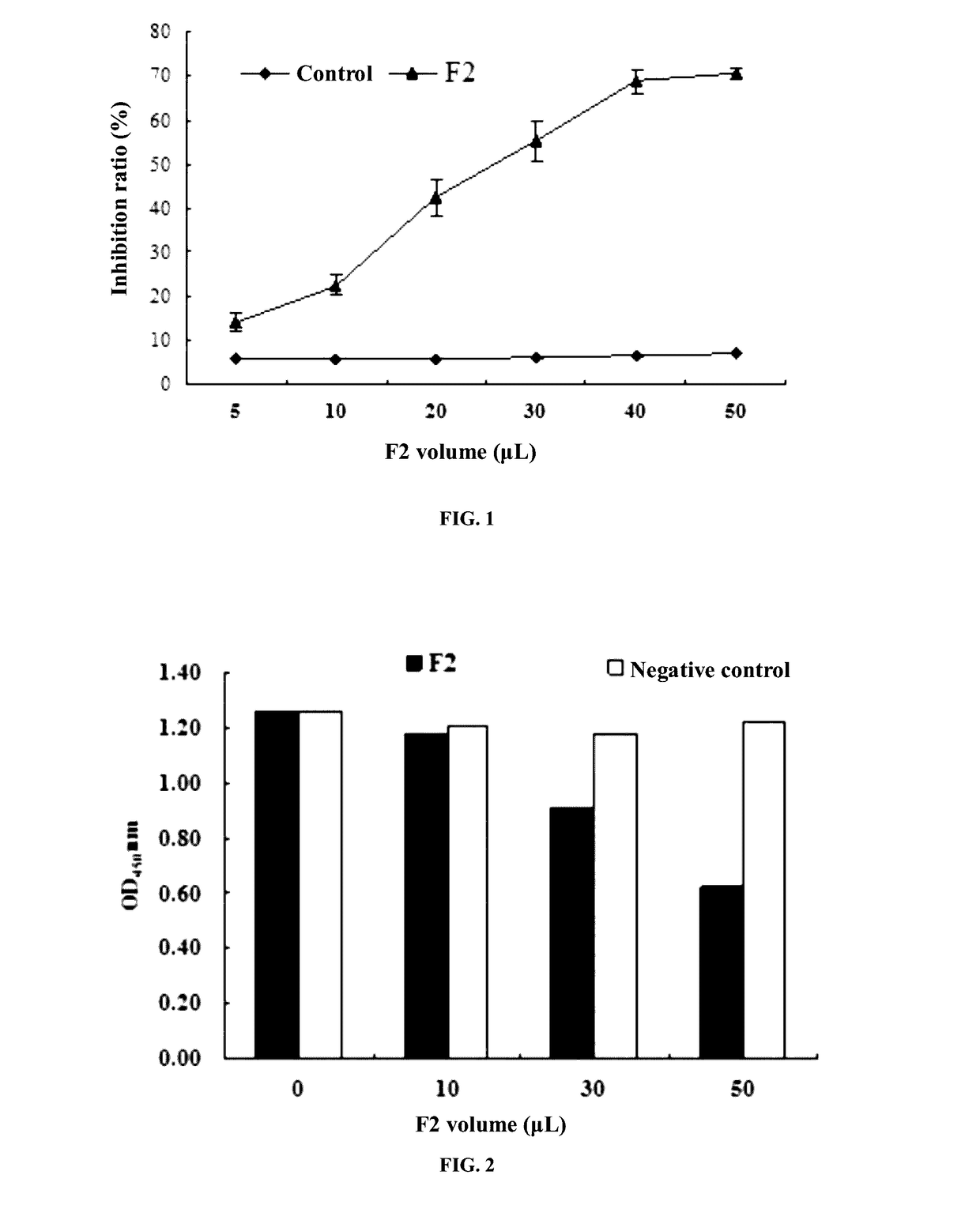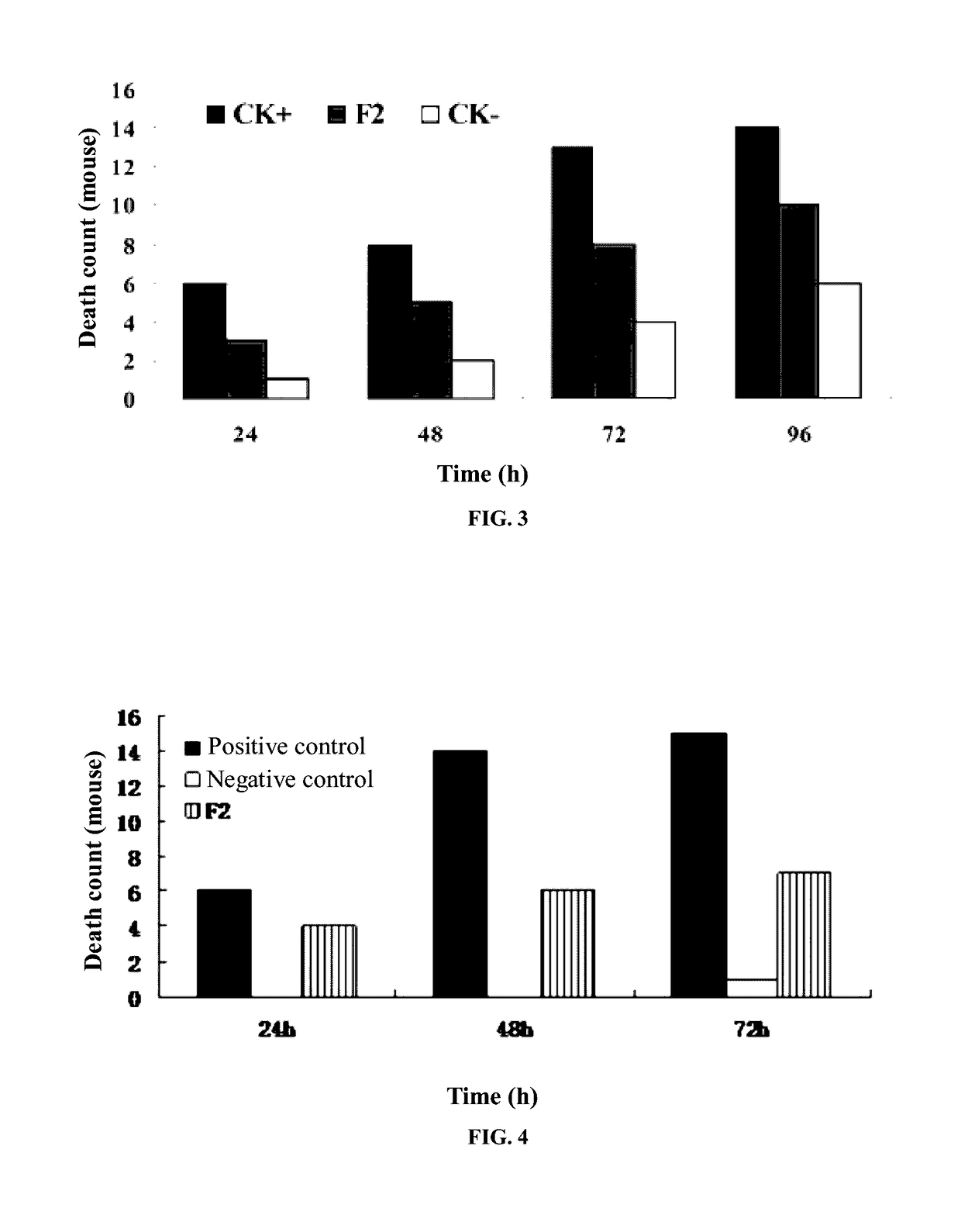A human-derived insecticidal gene and insecticidal peptide encoded thereby and application thereof
a technology of human-derived insecticidal gene and insecticidal peptide, applied in the field of genetic engineering and biological control, can solve the problems of significant decrease of total white blood cells (wbc) and hemoglobin (hgb) of animals
- Summary
- Abstract
- Description
- Claims
- Application Information
AI Technical Summary
Benefits of technology
Problems solved by technology
Method used
Image
Examples
embodiment 1
ticidal Peptide
[0053](1) Add 20 μl of humanized phage antibody library bacterium liquid to 200 ml of 2×TY-AG fluid medium, cultivate it at constant temperature of 37° C. till OD600 is 0.4, measure 50 ml of the bacterium liquid, add 1×1012 pfu of helper phage KM13 for superinfection, incubate the liquid at 37° C. for 30 minutes, then centrifuge it at 3300 g for 10 minutes, discard the supernate, use 100 ml of 2×TY-AKG fluid medium to resuspend the precipitate and cultivate it at 30° C. overnight; centrifuge it at 3300 g for 30 minutes next day, collect the supernate, add 20 ml of PEG / NaCl solution, keep it in ice bath for 1 h, then centrifuge it at 3300 g for 30 minutes and resuspend the precipitate by 4 ml of PBS; centrifuge the resuspension solution at 11600 g for 10 minutes. The supernate is amplified phage antibody library;
[0054](2) Use the amplified phage antibody library obtained in step 1 for four rounds of Panning: The screening method is positive and negative screening. Nega...
embodiment 2
ary Culture of F2
[0062]The supernate obtained through screening in Embodiment 1 and containing insecticidal peptide is transferred to 10 ml of 2×TY-AG fluid medium at a volume ratio of 1:100 and incubated at 37° C. for 2 h. 100 μl of helper phage KM13 with titer of 1012 is added for rescue, incubated at 30° C. for 2 h and centrifuged at 1800 g for 10 minutes. The supernate is removed. 2×TY-AK fluid medium is used to resuspend the precipitated bacteria. It is cultivated while being shaken at 30° C. with 250 rpm overnight. Next day it is centrifuged at 1800 g for 30 minutes. Its supernate is supernate containing F2 primary culture.
embodiment 3
tification of F2
(1) ELISA Detection Experiment of Competitive Inhibition
[0063]The experiment adopts 6 experimental groups and corresponding control groups. Solutions are prepared based on Table 1.
TABLE 1Preparation of solutions for ELISA detection experiment of competitiveinhibitionIrrelevant Anti-Id2 × TY fluidGroupF2single-chain antibodymediumExperimental group 1 5 μl45 μlControl group 1 5 μl45 μlExperimental group 210 μl40 μlControl group 210 μl40 μlExperimental group 320 μl30 μlControl group 320 μl30 μlExperimental group 430 μl20 μlControl group 430 μl20 μlExperimental group 540 μl10 μlControl group 540 μl10 μlExperimental group 650 μlControl group 650 μl
[0064]In Table 1, F2 is the supernate obtained in Embodiment 2 and containing F2 primary culture;[0065]Add 50 μl of 10 μg / ml anti-Cry2Aa polyclonal antibody to the solutions prepared in Table 1 respectively, incubate them at 37° C. for 2 h, add them to a 96-well plate coated with 2 μg / ml Cry2Aa toxin respectively (the 96-well pl...
PUM
 Login to View More
Login to View More Abstract
Description
Claims
Application Information
 Login to View More
Login to View More - R&D Engineer
- R&D Manager
- IP Professional
- Industry Leading Data Capabilities
- Powerful AI technology
- Patent DNA Extraction
Browse by: Latest US Patents, China's latest patents, Technical Efficacy Thesaurus, Application Domain, Technology Topic, Popular Technical Reports.
© 2024 PatSnap. All rights reserved.Legal|Privacy policy|Modern Slavery Act Transparency Statement|Sitemap|About US| Contact US: help@patsnap.com









